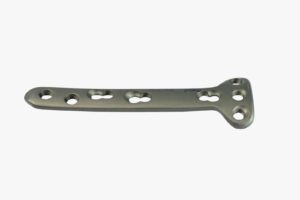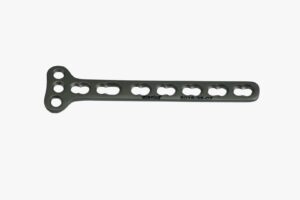| TITANIUM GR-V | – |
| STAINLESS STEEL 316L | 3112-35-SL+R |
| DIA/WIDTH | 4.5 X 60MM |
| SIZE | SMALL, MEDIUM, LARGE |
| MAIN CATEGORY | TRAUMA PLATING |
| CATALOGUE WISE | PELVIC |
An Anatomical Pelvic Plate LCP (Locking Compression Plate) is an orthopedic implant designed for the surgical treatment of fractures and injuries to the pelvic ring and acetabulum, which are the bony structures surrounding the hip joint. These plates are specially designed to match the anatomy of the pelvic region and provide stability and support during the healing process.
Anterior quadrilateral plate for fixation of anterior acetabular fracture involving medial wall. The quadrilateral plate (QP) is the relatively flat surface of bone in the true pelvis lying directly medial to the acetabulum.
-
- Covers the entire anterior column and medial wall.
-
- 5mm locking screw going in posterior column gives extra stability and flexibility to fix posterior column fracture from anterior exposure.
-
- 3.5mm locking screw anterior going in iliopubic eminence and superior pubic remi provide option to fix anterior column from ilio femoral approach.
-
- Anterior plate extension provide option for remi fixation.
-
- 5 mm locking screw fixation in supra acetabular area and sciatic buttress
-
- Its is used in all types of acetabulums.
-
- The only anatomical plate designed with perfection for reduction & fixation.
-
- All instruments & reduction tools supplied complimentary with plate.
-
- Guidance and assistance of experts available.
Specification
- Design: The Anatomical Pelvic Plate LCP is specifically shaped to conform to the unique anatomy of the pelvic ring and acetabulum. It is made from biocompatible materials such as stainless steel or titanium to minimize the risk of adverse reactions.
- Acetabular and Ilium Components: The plate often consists of two components: one for the acetabulum and another for the ilium (the upper, wing-shaped part of the pelvic bone). These components are anatomically contoured to match the respective bone surfaces.
- Locking Compression Plate (LCP): The plates incorporate the principles of locking compression plates, with screw holes designed to accommodate locking screws. These locking screws provide angular stability and maintain the alignment of the fractured bones.
- Screw Holes: The plate has multiple holes for screws, which are inserted into the pelvic bones to secure the plate and provide additional stability.
- Variable Angle Locking: Some Anatomical Pelvic Plate LCPs have variable angle locking options for screws, allowing surgeons to choose optimal screw placement and trajectory based on the specific fracture pattern.
Common Uses:
- Pelvic Fractures: Anatomical Pelvic Plate LCPs are primarily used in the treatment of pelvic fractures, particularly those involving the acetabulum and the ilium. Pelvic fractures can result from high-impact trauma, such as motor vehicle accidents or falls from heights.
- Stabilization of Acetabulum: The acetabular component of the plate is used to stabilize fractures of the acetabulum, which is the cup-shaped socket of the hip joint. Stable fixation is crucial for preserving the function of the hip joint.
- Ilium Fractures: The ilium component of the plate is used to stabilize fractures of the ilium, which is the large, wing-like part of the pelvic bone. Fractures in this area can be complex, and the plate helps maintain proper alignment.
- Angular Stability: The Locking Compression Plate (LCP) component of the plate provides angular stability to the fracture, reducing the risk of implant failure and ensuring that the bones heal in the correct anatomical alignment.
- Complex Fractures: Anatomical Pelvic Plate LCPs are used in cases of complex pelvic fractures that may require additional stability and support for proper bone healing.
- Minimizing Complications: These plates are designed to minimize complications associated with pelvic fractures, such as non-union (failure of the bones to heal) and postoperative displacement.





